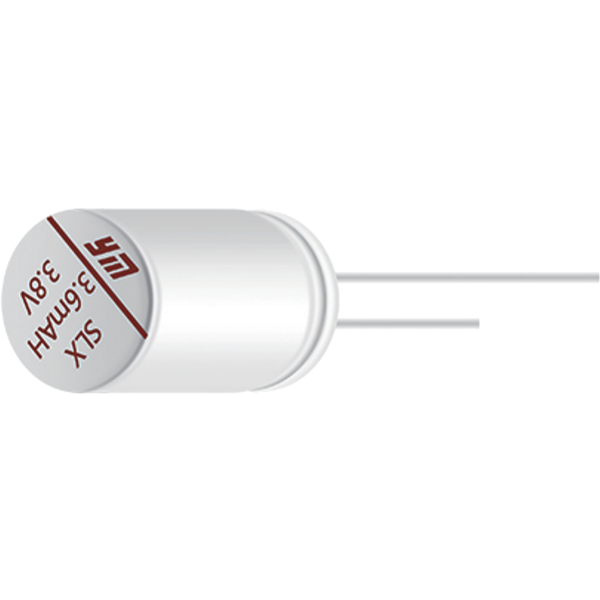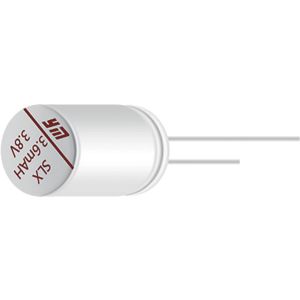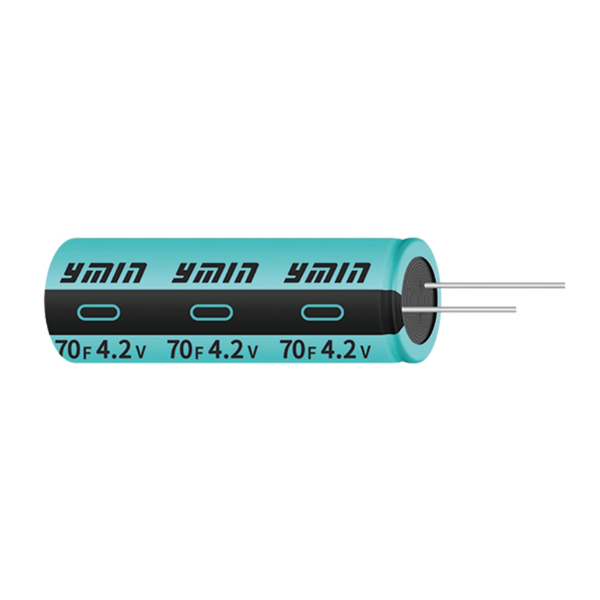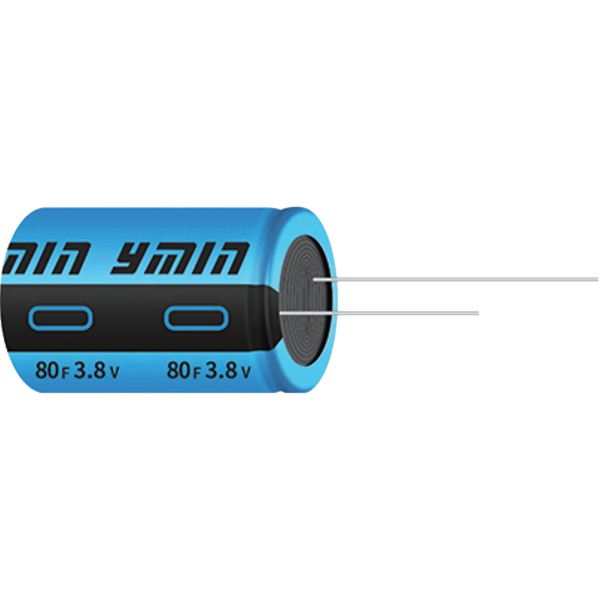Main Technical Parameters
| project | characteristic | |
| temperature range | -20~+85℃ | |
| Rated operating voltage | 3.8V-2.5V, maximum charging voltage: 4.2V | |
| Capacitance range | -10%~+30%(20℃) | |
| Durability | After continuously applying the rated voltage (3.8V) at +85°C for 1000 hours, when returning to 20°C fortesting, the following items are met | |
| Capacitance change rate | Within ±30% of initial value | |
| ESR | Less than 4 times the initial standard value | |
| High temperature storage characteristics | After 1000 hours of no-load storage at +85°C, when returning to 20°C for testing, the following items are met | |
| Capacitance change rate | Within ±30% of initial value | |
| ESR | Less than 4 times the initial standard value | |
Product Dimensional Drawing

a=1.0
| D |
3.55 |
4 |
5 |
6.3 |
| d |
0.45 |
0.45 |
0.5 |
0.5 |
| F |
1.1 |
1.5 |
2 |
2.5 |
The main purpose
♦Electronic bracelet
♦Wireless earphones, hearing aids
♦Bluetooth thermometer
♦Pen for touch screen, remote control pen for mobile phone
♦Smart dimming sunglasses, electronic dual-purpose glasses for far and nearsightedness
♦Wearable terminal electronic equipment, wireless communication equipment, IoT terminals and other small devices
YMIN SLX Series Lithium-Ion Capacitors: An Energy Revolution for Micro Devices, Ushering in a New Era of Portable Electronics
The rapid development of smart wearables, IoT devices, and portable electronics is placing unprecedented demands on energy storage components: smaller size, higher energy consumption, faster charging, and longer lifespan. Traditional batteries and supercapacitors often struggle to meet all of these demanding requirements simultaneously. With its forward-thinking technological vision, YMIN Electronics has introduced the SLX series of ultra-small lithium-ion capacitors (LICs), which perfectly address this conflict and provide a revolutionary energy solution for miniaturized, high-frequency electronic devices.
I. Technological Revolution: Overturning Traditional Energy Storage Philosophy
Lithium-ion capacitors are more than a simple technological overlay; they represent a true energy storage revolution. They cleverly combine the high energy density of lithium-ion batteries with the fast charge/discharge and long life of supercapacitors, creating a unique hybrid energy storage mechanism.
The YMIN SLX series boasts remarkable core technological advantages:
• Ultra-high operating voltage platform: Rated voltage up to 3.8V, with a maximum charge voltage of 4.2V. Compared to the 2.7V or 3.0V voltage platforms of traditional supercapacitors, this means that within the same volume, the energy stored (energy density) far exceeds that of the latter. Official data indicates that its capacity is 10 times that of electric double-layer capacitors of the same volume.
• Extremely Miniaturized Design: This series of products are extremely small, with diameters ranging from 3.55mm to 6.3mm and lengths from 7mm to 12mm. This ultra-compact design allows for easy integration into space-critical micro-devices, making it a truly valuable component for modern electronic designs where space is at a premium.
• Ultra-Low Self-Discharge: This series solves the short energy retention problem of traditional capacitors. The SLX series can retain its stored charge longer, ensuring standby power when idle and reducing the need for frequent charging.
• Amazingly Fast Charging: Thanks to its hybrid principle, it can achieve charging speeds of seconds or even faster, achieving "discharge-and-charge" functionality. This makes it particularly suitable for applications requiring frequent, short-term charging, significantly improving the user experience.
II. Superior Performance: Proven Reliable Quality
To ensure long-term, reliable operation in micro devices, YMIN subjected the SLX series to extremely stringent testing standards, and its performance remains exceptional:
• Wide operating temperature range (-20°C to +85°C): Ensures stable operation in a variety of environments, from winter outdoors to summer heat.
• 1000-hour endurance test: After continuously applying a rated voltage of 3.8V at +85°C for 1000 hours, the capacity change remains within ±30% of the initial value, and the equivalent series resistance (ESR) change is controlled within 4 times the initial standard value. This demonstrates its excellent high-temperature tolerance and long life.
• Stable high-temperature storage characteristics: After 1000 hours of no-load storage at +85°C, the performance parameter degradation meets strict standards, demonstrating the high stability of its material system and internal structure.
III. Precision Applications: The Core of the Micro-Intelligent World
These features make the SLX series the ideal "heart" for the following cutting-edge microelectronic devices:
1. Smart Wearables and Health Monitoring:
◦ Electronic Bracelets/Smartwatches: Providing sufficient power within extremely limited space to support functions such as heart rate monitoring and activity tracking, while also enabling fast charging to alleviate user battery life concerns.
◦ Wireless Bluetooth Headphones/Hearing Aids: Providing high transient current to support high-quality audio output, while its ultra-small size perfectly fits within its compact design. The charging pod can recharge the LIC multiple times in a short period of time.
◦ Portable Medical Devices such as Bluetooth Thermometers: Providing long-term, stable energy support to ensure continuous and reliable medical data monitoring.
2. Smart Interaction and Internet of Things (IoT) Terminals:
◦ Touchscreen Stylus/Mobile Remote Control Stylus: Utilizing a passive or semi-active design, it offers long battery life with fast charging, enhancing writing fluidity and the interactive experience.
◦ Smart photochromic glasses/electronic dual-purpose glasses: Provide instantaneous energy to the micro-actuators and circuit systems in the lenses, enabling focus adjustment or color change. LIC's long lifespan ensures product durability.
◦ Distributed IoT sensor nodes: Especially in applications utilizing energy harvesting (such as solar and kinetic energy), LIC can efficiently store the collected tiny amounts of energy and provide peak power when data transmission is needed.
3. Other high-end consumer electronics:
◦ Portable beauty devices, smart rings, electronic tags, and any other innovative product requiring a miniaturized, efficient, and fast-charging energy solution: the SLX series provides strong technical support.
IV. Advantage Comparison: Why Choose LIC?
Compared to traditional energy solutions, the SLX series lithium-ion capacitors offer overwhelming advantages:
• Compared to traditional supercapacitors: Energy density is an order of magnitude higher, voltage levels are higher, and self-discharge rates are lower, allowing for smaller size while maintaining the same energy requirements.
• Compared to lithium-ion batteries: higher power density, extremely fast charging speeds (measured in seconds/minutes), longer cycle life (up to tens of thousands of times), improved safety, and the absence of heavy metals and other toxic substances, making it more environmentally friendly and safe.
Conclusion: Partner with YMIN to lead the future of miniaturized energy
The YMIN SLX series of ultra-small lithium-ion capacitors is more than just a component; it is the key to unlocking the next generation of miniaturized smart devices. It represents the forefront of energy storage technology towards miniaturization, efficiency, and environmental protection. Whether you are designing a disruptive wearable device or developing and deploying a widespread IoT sensor network, the SLX series provides you with reliable, efficient, and competitive energy solutions.
Choosing YMIN means choosing a strong technology partner. We are committed to continuously pushing the boundaries of lithium-ion capacitor technology. With innovative products and superior quality, we can help you realize your ideas and jointly define the future of smart and convenient digital life.
| Products Number | Working Temperature (℃) | Rated Voltage (Vdc) | Capacitance (F) | Width (mm) | Diameter(mm) | Length (mm) | Capacity (mAH) | ESR (mΩmax) | 72 hours leakage current (μA) | Life (hrs) |
| SLX3R8L1550307 | -20~85 | 3.8 | 1.5 | - | 3.55 | 7 | 0.5 | 8000 | 2 | 1000 |
| SLX3R8L3050409 | -20~85 | 3.8 | 3 | - | 4 | 9 | 1 | 5000 | 2 | 1000 |
| SLX3R8L4050412 | -20~85 | 3.8 | 4 | - | 4 | 12 | 1.4 | 4000 | 2 | 1000 |
| SLX3R8L5050511 | -20~85 | 3.8 | 4 | - | 5 | 11 | 1.8 | 2000 | 2 | 1000 |
| SLX3R8L1060611 | -20~85 | 3.8 | 10 | - | 6.3 | 11 | 3.6 | 1500 | 2 | 1000 |



.png)

